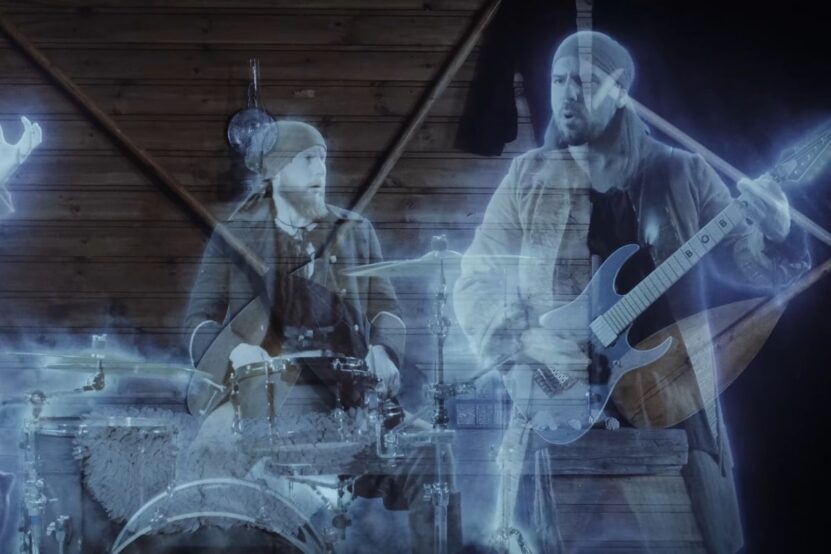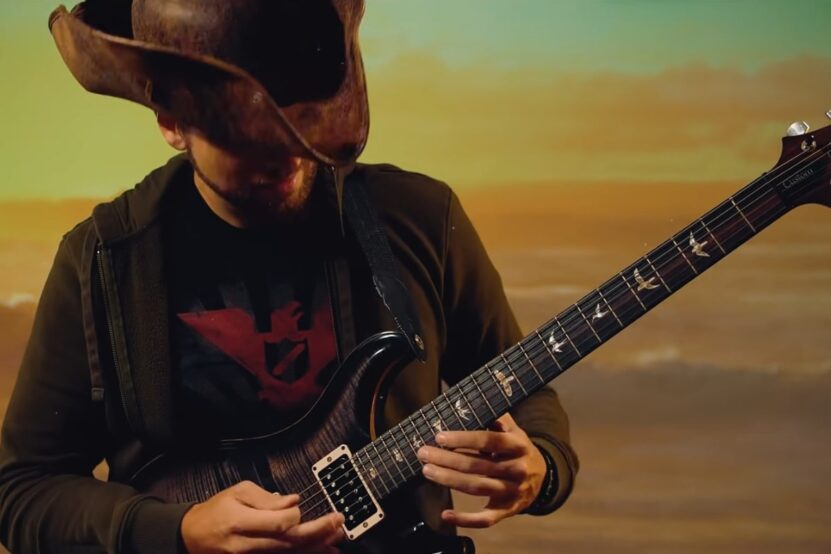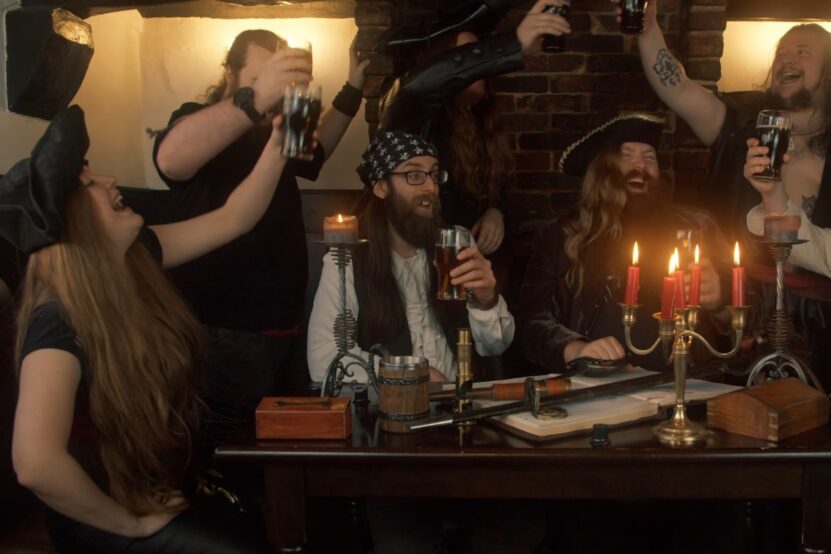Pirate metal is more than just a subgenre of heavy metal; it’s a theatrical experience that brings the tales of the high seas to life. This unique style is deeply rooted in pirate mythology, often evident in both the music and the live performances.
The lyrics, rich with piratical jargon, transport listeners to a world of swashbuckling adventures, while the melodies often blend various heavy metal genres, such as thrash, speed, and folk metal, with traditional sea shanties. This fusion creates a distinctive sound, further enhanced by the use of folk instruments like the concertina.
Modern technology also plays a role, with synthesizers emulating these traditional instruments. The theatrical element is not just limited to the music; band members often don period costumes for their performances, immersing their audience in the thematic experience.
It’s not uncommon for concert-goers to join in, dressing up in their best picaroon attire. The media often labels this vibrant community as a music scene, highlighting its cultural significance.
Is It a Genuine Genre?

The authenticity of pirate metal as a genre has been a topic of debate. While it’s undeniable that it’s a relatively recent addition to the music world, having been around for just a few decades, its distinct characteristics make it stand out.
Only a select few bands truly embody the essence of this kind of music, and it hasn’t reached the heights of mainstream popularity. However, its unique blend of pirate mythology, folk instruments, and playful humor sets it apart from other heavy metal genres, marking its place in the music industry.
Tracing Back the Roots
The inception of pirate metal is often attributed to the German band, Running Wild. Their 1987 album, “Under Jolly Roger,” is hailed as the pioneer of this kind of metal.
Not only was it a commercial success, but it also received critical acclaim, setting the stage for the genre’s future.
Sailing the High Seas
Since the release of “Under Jolly Roger,” the pirate metal scene has witnessed the emergence of several bands, each bringing their unique flair to the genre. Bands like Alestorm, Swashbuckle, and The Dread Crew of Oddwood have not only popularized pirate metal but have also played a pivotal role in introducing it to a broader audience.
Defining the Genre
- Pirate Mythology and Imagery: This kind of metal is deeply rooted in the tales of the high seas. Lyrics often revolve around pirates, their ships, and ocean adventures. The stage performances are enhanced with costumes and props reminiscent of the pirate era.
- Folk Instruments: To capture the essence of sea shanties, pirate metal bands often incorporate folk instruments, giving their music a traditional touch.
- Humor in Lyrics: A defining trait of pirate metal is its playful, tongue-in-cheek humor, setting it apart from more serious heavy metal genres.
- Energetic Sound: Pirate metal is known for its fast tempo and aggressive sound, drawing parallels with genres like thrash and speed metal.
Comparison to Other Genres

Pirate metal stands distinct yet shares facets with genres like sea shanties and folk music. At the heart of both pirate metal and sea shanties is storytelling, painting vivid images of maritime adventures and pirates.
Pirate metal introduces a heavy metal edge to these tales, whereas sea shanties retain their traditional call-and-response style.
Instrumental Fusion
In terms of instrumentation, pirate metal frequently blends in folk instruments to mirror the soundscapes of sea shanties. Contrastingly, folk music leans heavily on traditional instruments such as the fiddle, accordion, and mandolin.
This amalgamation of electric guitars and folk instruments in pirate metal sets it apart from the unadulterated sounds of folk.
Different Themes
Diving into themes, pirate metal predominantly revolves around pirate lore and escapades. Folk music, however, casts a wider thematic net, touching upon love, war, and societal reflections.
Sea shanties, being more niche, often echo the sentiments of sailors, their camaraderie, tasks, or yearnings for home.
Contrasting Performances

The ambiance of performances also varies. Pirate metal shows are theatrical spectacles with performers often clad in thematic attire.
Sea shanties, in their original context, served a functional purpose, sung to accompany tasks on ships. Folk music, with its rich history, spans a spectrum from cozy, intimate sessions to grand festivals, always emphasizing community and the art of storytelling.
Evolutionary Trajectories
@jonathanymusic MAN THE CANNONS 🏴☠️ #metal #pirate #pirates #piratemetal #metalhead #originalmusic #fyp #metaltok #piratetok ♬ original sound – Jonathan Young Music
On the evolutionary front, pirate metal is a budding genre, born from fusing heavy metal elements with pirate-centric themes. Sea shanties, despite their age-old origins, have found renewed fame, particularly on modern platforms like TikTok.
Folk music, with its timeless essence, remains both an influencer and an influence in the ever-evolving music world.
To sum it up, this kind of metal, while drawing from the wells of sea shanties and folk, has etched its unique mark in the music world, promising listeners an invigorating musical voyage.
Leading Bands
- Alestorm
- Swashbuckle
- The Dread Crew of Oddwood
- Running Wild
- Captain Morgan’s Revenge
- Rumpelstiltskin
Top Albums to Begin With
- Under Jolly Roger by Running Wild
- Captain Morgan’s Revenge by Alestorm
- Back to the Noose by Swashbuckle
- Tortuga by The Dread Crew of Oddwood
- Rum is the Life by Rumpelstiltskin
- Seven Seas of Rhye by Gloryhammer
FAQ
Where can I find this kind of music?
Pirate metal music can be found on a variety of streaming platforms, such as Spotify, Apple Music, and YouTube. You can also find albums and merchandise at online retailers, such as Amazon and Bandcamp.
Is pirate metal a good genre of music?
Whether or not pirate metal is a good genre of music is a matter of personal opinion. Some people love the fast tempo, aggressive sound, and humor of this kind of metal, while others find it to be too silly or over-the-top.
Ultimately, the best way to decide if this kind of metal is a good genre of music for you is to listen to it for yourself.
What are some of the most common instruments used in pirate metal?
The most common instruments used in pirate metal are the electric guitar, drums, bass guitar, and vocals. However, some bands also incorporate folk instruments, such as the accordion, violin, and concertina.
Final Words
Pirate metal, a subgenre of heavy metal, is a captivating blend of theatricality, mythology, and musical prowess. It’s not just about the music; it’s an immersive experience that transports listeners to the golden age of piracy.
With its roots deeply anchored in picaroon tales, the genre offers a unique soundscape, blending the aggression of heavy metal with the nostalgia of sea shanties. The authenticity of pirate metal may be debated, but its distinct identity is undeniable.
Bands like Running Wild and Alestorm have championed this genre, introducing it to audiences worldwide. Whether you’re drawn to its playful humor, the allure of buccaneer tales, or its energetic sound, pirate metal promises an unforgettable voyage.
So, hoist the sails and embark on this musical adventure, for it’s a journey that resonates with the spirit of freedom, adventure, and rebellion.